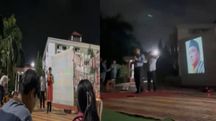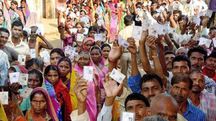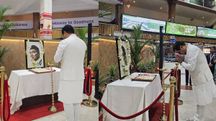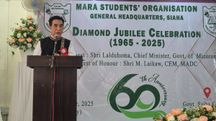'The Last Free Naga' reveals tales of identity, conflict and enduring resilience
Jim Wungramyao Kasom writes with a courage that strips away illusions, revealing the raw pulse of human struggle and resilience. 'The Last Free Naga' lingers in the mind, haunting and beautiful, long after the last page is turned.

- The book offers honest stories from Manipur’s ongoing crisis
- It highlights the Naga-Kuki feud and regional conflicts
- Tribal culture and traditions are central themes throughout
An author becomes daring, and a book earns the stature of a masterpiece, when narratives are approached head-on with brutal honesty and unflinching fearlessness. At a time when Manipur rests in the throes of a "crisis," Jim Wungramyao Kasom pours his heart and mind into 'The Last Free Naga' — a collection that journeys across terrains of joy and sorrow, hope and despair, beauty and tragedy.
"Life in Imphal is as cheap as the goods that come from Moreh, the Indo-Myanmar border town. It's as if all lives being manufactured here come with a finite warranty." This haunting line sets the tone for the collection, a reminder that in Manipur, existence itself has been diminished by violence and uncertainty. Kasom does not soften the blow; instead, he compels the reader to confront the harsh truth of lives lived under siege.
To read this book while Manipur grapples with unending chaos and conflict feels eerily timely. Yet, amid the growling realities, Kasom threads in the richness of the land, the poetry of its hills, the quiet beauty of its culture and resilience embedded in its people.
Much of the book unfolds in Ukhrul, dwelling on the Naga-Kuki feud and the Naga national movement. These are not distant abstractions but lived realities, presented through stories that carry both historical weight and personal ache.
The author draws us into the long-standing tensions - whether with the NSCN-IM, the imposition of AFSPA, or the presence of Assam Rifles - that have shaped Manipur’s landscape. The collection stands as a reminder of a land marred by relentless conflict.
An extract from one of the stories reveals the heart of Kasom's writing: "The Naga national movement had spawned men who existed like taboos, whispered about only in hushed silence. In waging a war of freedom, was their freedom the first casualty? Or was standing up for one's belief in itself a kind of freedom? Where did they belong if they could not roam freely in their homeland?" Isn't the paradox of freedom in bondage, of identity both fragile as well as indestructible?
But 'The Last Free Naga' is not merely a chronicle of conflict. It is a tapestry woven with everyday intimacies...the bonds of cousins, the sacrifices of parents, the quiet force of faith, the reverence for nature, and even calamities. It is an amalgamation of values, histories, and human experiences that shape identity.
At its essence, the book is not just a retelling of folktales or communal memory; it is a plea for preservation. It speaks to the urgency of safeguarding tribal identities, traditions, and cultures, not as artefacts but as living legacies.
Kasom’s stories move like shifting winds: they make you smile with their tenderness, and wound you with their truths. They stir nostalgia, grief, and the kind of boundless sadness that lingers long after the last page.
For many readers, the book is also an initiation into the Northeast - its mythical beings, its haunting legends, and its awe-inspiring landscapes. And alongside this beauty, Kasom lays bare the atrocities endured by its people.
One of the striking aspects of the book is its evocative portrayal of Shillong, painted with a lyricism rare in contemporary writing. "In Shillong, winter descended like flamingos on cherry trees. Watching the season change in a new place was quite an adventure in itself." Seems like a gentle reminder that even amid turmoil, there exists a world of startling grace.
The text is subtle yet gripping, lined with stories that beckon the reader forward. From mythical creatures that terrify to familial prayers that comfort, Kasom anchors readers in a world that pulls at familiarity.
While his motive may not seem apparent in the opening chapters, it becomes clear that his narrative is both personal and political. His longing is unmistakable: to keep alive his tribe’s identity, history, and homeland for future generations.
His portrayal of a war-torn state is stark, but what elevates the collection is the compassion with which he writes about villagers, their resilience, and their humanity.
"The boy tried to remember the last time his father had held him in his arms. All hugs stopped when he was old enough to have his own memories. They were not sentimental people, not folks in the village! The closest bonding was when they prayed together."
Kasom magnifies his narrative through imagery as piercing as his themes, evoking in readers a sense of both belonging and estrangement. For some, 'The Last Free Naga' will feel like a return to forgotten stories; for others, it is a revelatory glimpse into the beauty, the intimate, unspoken secrets of a land that continues to fight for its voice in the chorus of history.
Publisher: Speaking Tiger
Copyright©2025 Living Media India Limited. For reprint rights: Syndications Today









